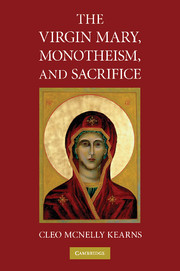Book contents
- Frontmatter
- Contents
- Preface
- Acknowledgments
- Introduction: A Vehement Flame
- PART ONE THEORIES OF SACRIFICE
- PART TWO MARY, MOTHERHOOD, AND SACRIFICE IN THE GOSPELS
- 4 Daughter of Zion: Mary in Matthew and Mark
- 5 The New Abraham: Mary in Luke
- 6 The Sorrowful Mother: Mary in John
- PART THREE MARY AND PRIESTHOOD
- Conclusion: Beyond Orthodoxy
- Notes
- Index
6 - The Sorrowful Mother: Mary in John
Published online by Cambridge University Press: 27 July 2009
- Frontmatter
- Contents
- Preface
- Acknowledgments
- Introduction: A Vehement Flame
- PART ONE THEORIES OF SACRIFICE
- PART TWO MARY, MOTHERHOOD, AND SACRIFICE IN THE GOSPELS
- 4 Daughter of Zion: Mary in Matthew and Mark
- 5 The New Abraham: Mary in Luke
- 6 The Sorrowful Mother: Mary in John
- PART THREE MARY AND PRIESTHOOD
- Conclusion: Beyond Orthodoxy
- Notes
- Index
Summary
The union of the Mother and the Son in the work of redemption reaches its climax on Calvary, where Christ “offered himself as the perfect sacrifice to God” (Heb. 9:14) and where Mary stood by the cross (John 19:25), suffering grievously with her only begotten Son. There she united herself with a maternal heart to His sacrifice.
Ambrose“Go, your son will live.”
John 4:50The typology that links mary and abraham together and ties both to the discourse of sacrifice becomes most significant in the context of the gospel of John. Here the parallels we have been discussing are given a new dimension, for Mary's instigation of her son's transformation of water into wine for a wedding feast echoes Abraham's hospitality to the other in Genesis, and her presence at the crucifixion on Golgotha echoes his ascent to Mount Moriah to bind his son on the altar. By allowing these texts and figures to resonate together, we can trace the process by which parenthood moves from the biological to the cultural level. We can also see how religious traditions are forged in which Mary will come to function, figuratively speaking, as the Mother of the Church and sign of eschatological fulfillment to come just as Abraham has come to function as the Father of the Faithful and the first to affirm the promise of redemption for future generations.
- Type
- Chapter
- Information
- The Virgin Mary, Monotheism and Sacrifice , pp. 166 - 194Publisher: Cambridge University PressPrint publication year: 2008



